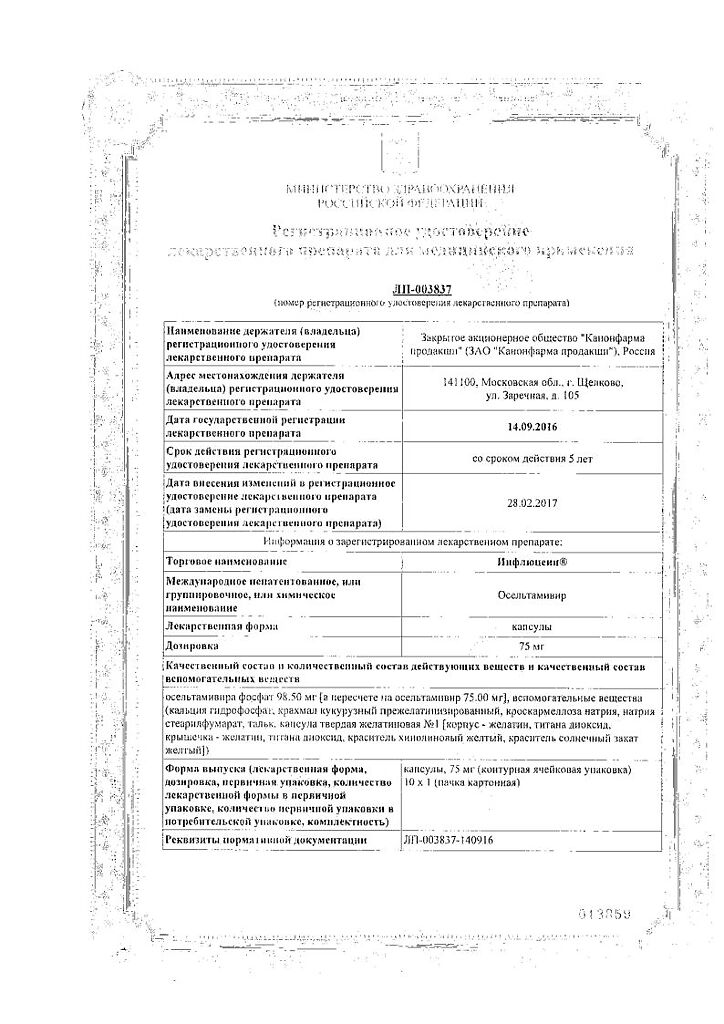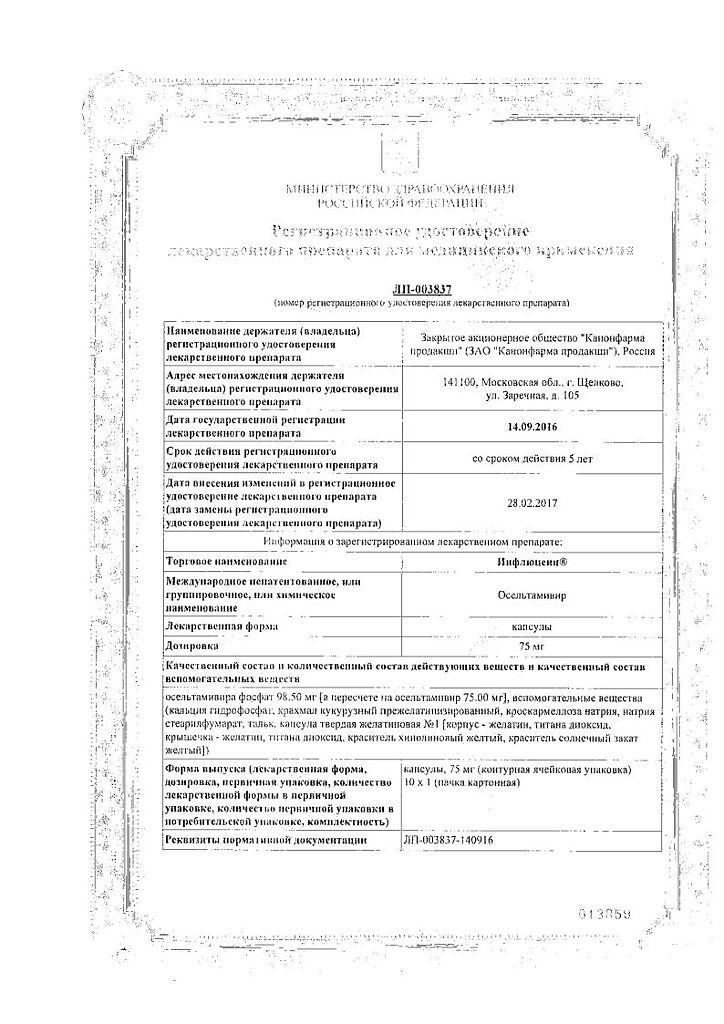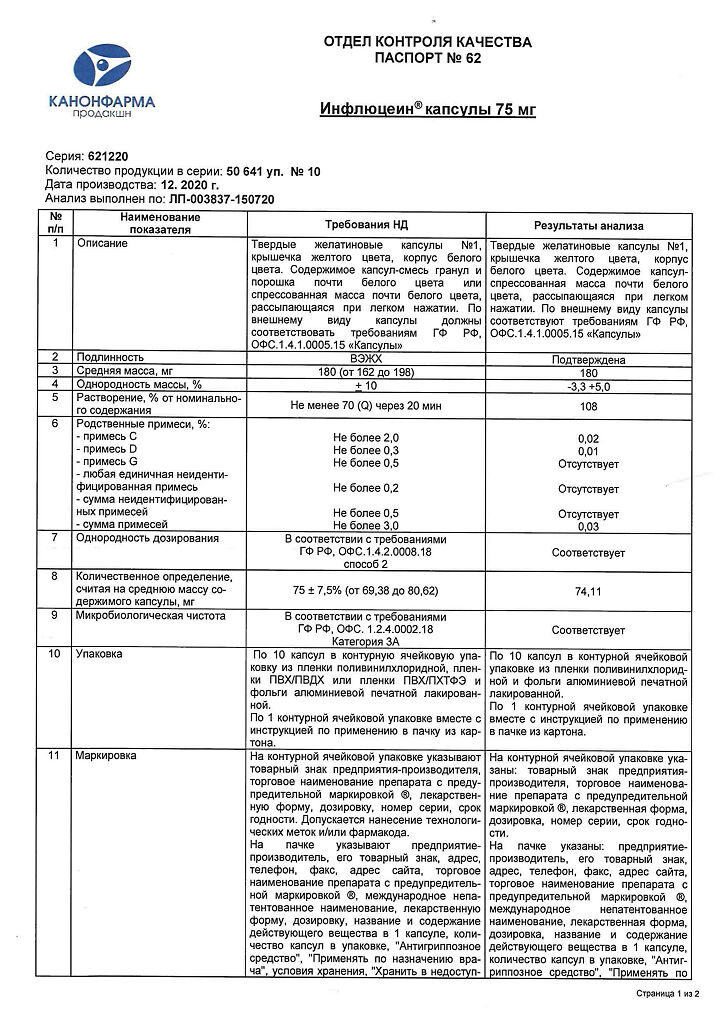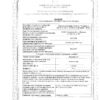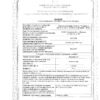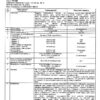No products in the cart.
Description
Antiviral agent. It is a prodrug, the active metabolite (oseltamivir carboxylate) of which selectively inhibits neuraminidase of influenza virus types A and B.
The neuraminidase is a glycoprotein which catalyzes the cleavage of the bond between the terminal sialic acid and sugar, thus contributing to the spread of the virus in the respiratory tract (virions exit from the infected cell and penetrate into the cells of the respiratory epithelium, preventing inactivation of the virus by the epithelial mucus).
Oseltamivir carboxylate acts outside the cells and competitively inhibits neuraminidase of the virus.
Inhibits influenza virus growth in vitro and suppresses viral replication and pathogenicity in vivo.
Reduces excretion of influenza A and B viruses from the body.
It does not affect the production of antibodies in response to the administration of inactivated influenza vaccine.
The resistance rate of clinical virus isolates is 2%.
Indications
Indications
Influenza types A and B.
Pharmacological effect
Pharmacological effect
Antiviral agent. It is a prodrug whose active metabolite (oseltamivir carboxylate) selectively inhibits neuraminidase of influenza virus types A and B.
Neuraminidase is a glycoprotein that catalyzes the cleavage of the bond between terminal sialic acid and sugar, thereby facilitating the spread of the virus in the respiratory tract (the release of virions from the infected cell and penetration into the epithelial cells of the respiratory tract, preventing inactivation of the virus by epithelial mucus).
Oseltamivir carboxylate acts outside cells and competitively inhibits viral neuraminidase.
Inhibits the growth of the influenza virus in vitro and suppresses the replication of the virus and its pathogenicity in vivo.
Reduces the release of influenza A and B viruses from the body.
Does not affect the production of antibodies in response to inactivated influenza vaccine.
The resistance rate of clinical isolates of the virus is 2%.
Special instructions
Special instructions
Use with caution in children.
In patients with hepatic impairment, the safety and effectiveness of oseltamivir have not been established.
There is no data on the safety of oseltamivir with CC less than 10 ml/min.
Active ingredient
Active ingredient
Oseltamivir
Composition
Composition
1 caps.
oseltamivir phosphate
98.5 mg,
which corresponds to the content of oseltamivir
75 mg
Excipients:
calcium hydrogen phosphate – 25 mg,
pregelatinized corn starch – 46.3 mg,
croscarmellose sodium – 7.2 mg,
sodium stearyl fumarate – 1.5 mg,
talc – 1.5 mg.
Composition of the capsule body:
gelatin – 45.2956 mg, titanium dioxide – 0.9244 mg;
Composition of the capsule cap:
gelatin – 29.1077 mg, titanium dioxide – 0.3971 mg, quinoline yellow dye – 0.2739 mg, sunset yellow dye – 0.0013 mg.
Contraindications
Contraindications
Chronic renal failure (creatinine clearance less than 10 ml/min), liver failure, hypersensitivity to oseltamivir.
Side Effects
Side Effects
From the digestive system: nausea, vomiting (usually when taken in high doses, or in the first days of treatment); rarely – diarrhea, abdominal pain.
From the central nervous system: insomnia, dizziness, headache.
From the respiratory system: nasal congestion, sore throat, cough.
Other: feeling tired, weak.
Interaction
Interaction
Medicines that block tubular secretion increase the concentration of the active metabolite by 2-3 times (due to inhibition of the process of active tubular secretion in the kidneys), which does not require dose adjustment.
Recommendations for use
Recommendations for use
The method of administration and dosage regimen of a particular drug depend on its release form and other factors. The optimal dosage regimen is determined by the doctor.
Functional features
Functional features
After oral administration, it is almost completely absorbed from the gastrointestinal tract; absorption does not depend on food intake. Has a “first pass” effect through the liver. Under the influence of intestinal and hepatic esterases it turns into an active metabolite. 75% of the dose taken orally enters the systemic circulation in the form of an active metabolite, less than 5% in the form of the parent substance. Plasma concentrations of both the prodrug and the active metabolite are dose proportional.
The average Vd of the active metabolite is 23 l. Plasma protein binding – 3%.
It is excreted as an active metabolite mainly by the kidneys by glomerular filtration and tubular secretion. T1/2 of oseltamivir is 1-3 hours. Oseltamivir carboxylate is not further metabolized and is excreted by the kidneys, its T1/2 is 6-10 hours. Renal clearance is 18.8 l/hour. Less than 20% is excreted through the intestines.
In elderly patients (65-78 years), the concentration of the active metabolite at steady state is 25-35% higher than in younger patients. In patients with renal failure, the rate of elimination of oseltamivir carboxylate is inversely proportional to the creatinine clearance value.
Manufacturer
Manufacturer
Kanonpharma production CJSC, Russia
Additional information
| Manufacturer | Kanonfarma Production ZAO, Russia |
|---|---|
| Medication form | capsules |
| Brand | Kanonfarma Production ZAO |
Related products
Buy Influcein, capsules 75 mg 10 pcs with delivery to USA, UK, Europe and over 120 other countries.


